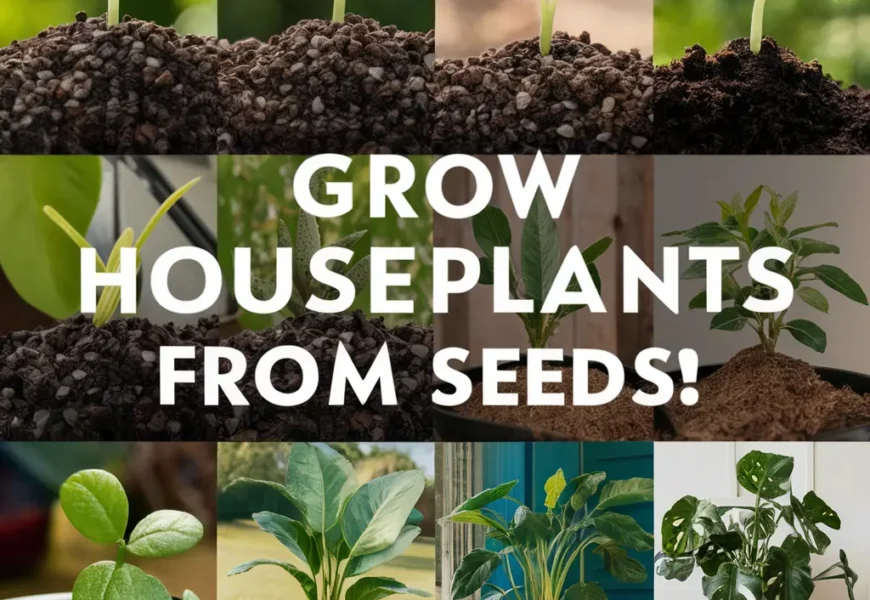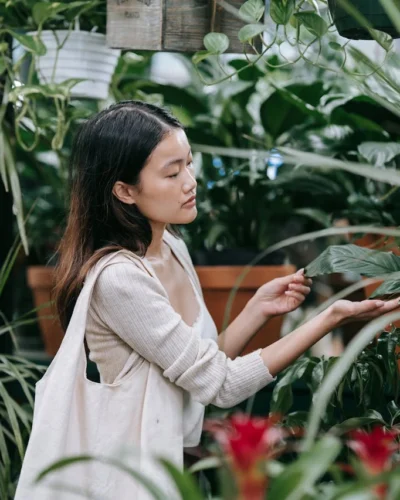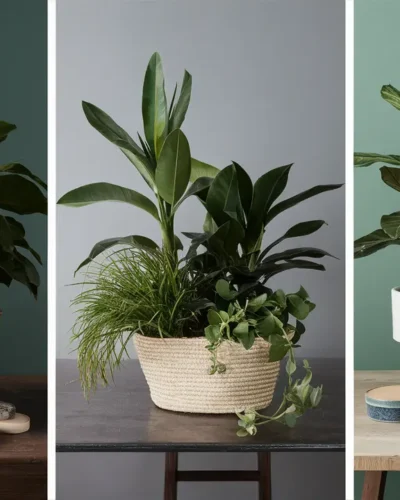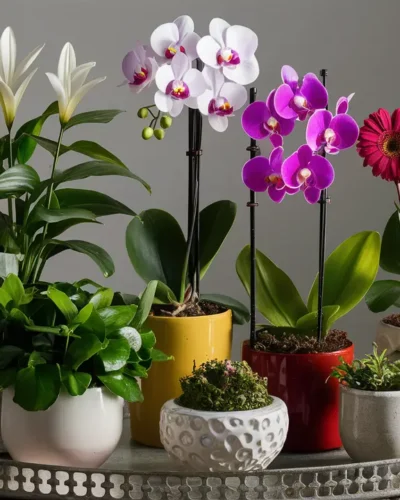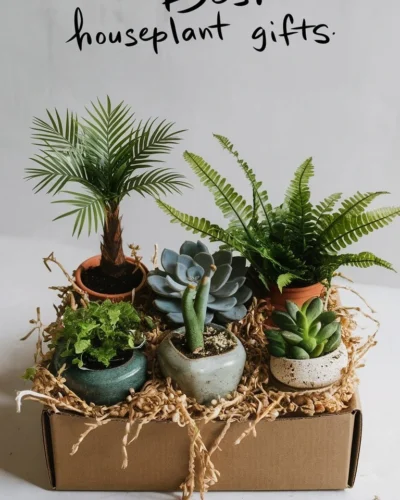Welcome to the enchanting realm of indoor gardening! Whether you’re an experienced plant enthusiast or a novice exploring the world of greenery, there’s a truly magical experience in growing houseplants from seeds to flourishing sprouts. In this guide, we will explore the houseplants you can grow at home from seed
We will delve into the delight and ease of creating your own indoor oasis with our selection of the top 10 houseplants that are not only simple to cultivate but also immensely rewarding.
Table of Contents
- Benefits of Growing Houseplants from Seeds
- Essential Supplies and Preparation
- Top 10 Houseplants You Can Grow Yourself
- A Step-by-Step Guide to Planting Seeds
- Troubleshooting Common Issues
- Celebrating Growth and Progress
- Conclusion
Let’s dive in and discover the joys of cultivating your own green sanctuary right in the comfort of your home!
Benefits of Growing Houseplants from Seeds
Embarking on the journey of growing houseplants from seeds offers a multitude of benefits, making it a rewarding and fulfilling experience. Here’s why starting from seeds is a fantastic option for both beginners and seasoned plant enthusiasts:
1. Cost-effectiveness
Purchasing seeds is often more economical than buying mature plants. Plus, a single packet of seeds can yield multiple plants, providing excellent value for your money. This means you can allocate your budget towards acquiring a wider variety of seeds, as discussed in our article on top 10 houseplant trends.
3. Wide Variety
Growing houseplants from seeds opens up a world of possibilities in terms of plant varieties. From colorful flowers to lush foliage, you have the freedom to choose from an extensive selection of seeds available in nurseries or online. Check out our guide on 20 gardening hacks for tips on selecting and caring for a diverse range of plants.
4. Educational Experience
Watching seeds germinate and grow into healthy plants offers a valuable learning opportunity. It allows you to understand the lifecycle of plants, the importance of nurturing, and the science behind cultivation. It’s a fantastic hands-on lesson for children and adults alike. Learn more about the educational benefits of gardening in our article on breathe easy: beautify your living room.
5. Greater Control
Starting from seeds gives you control over every stage of the plant’s growth. You can select the soil mix, monitor watering and lighting conditions, and ensure optimal care from the very beginning, leading to healthier and more resilient plants. Our article on boosting your indoor garden delves into the factors that contribute to plant growth and how to optimize them.
6. Satisfaction of Nurturing
There’s an unparalleled sense of achievement that comes with nurturing a plant from a tiny seedling to a thriving specimen. Witnessing the growth process firsthand and knowing that you played a part in it can be incredibly gratifying. For more tips on nurturing your plants, check out our guide on houseplant parenthood.
7. Access to Rare or Unique Varieties
Growing from seeds allows you to cultivate rare or unusual plant varieties that may not be readily available as mature plants. This gives you the opportunity to create a truly unique indoor garden filled with one-of-a-kind treasures. Explore our article on creating a beautiful indoor jungle for inspiration on incorporating exotic plants into your space.
8. Customization
When starting from seeds, you have the flexibility to tailor the growing conditions to suit the specific needs of each plant variety. Whether it’s adjusting the humidity levels, providing extra warmth, or controlling light exposure, you can customize the environment to maximize growth and health. Our article on the easy guide to self-watering houseplants offers insights into maintaining optimal moisture levels for your plants.
By harnessing the power of seeds, you can kickstart your indoor gardening journey with confidence and creativity, reaping the rewards of lush greenery and blooming beauties in your home.
Essential Supplies and Preparation
Before you dive into planting your houseplant seeds, it’s essential to gather the necessary supplies and prepare your space for optimal growth. Here’s a handy checklist to ensure you’re well-equipped for your indoor gardening adventure:
1. Seeds
Choose high-quality seeds from reputable sources to increase the likelihood of successful germination and healthy plant growth. Consider exploring our article on top light plants for varieties that thrive in different lighting conditions.
3. Containers
Select containers or pots that provide adequate drainage to prevent waterlogging and promote healthy root development. You can repurpose containers from around your home or invest in biodegradable seedling trays. Learn more about container options in our guide on choosing the best blinds for houseplants.
3. Potting Mix
Use a well-draining potting mix specifically formulated for starting seeds. Avoid using garden soil, as it may contain pests, diseases, or weed seeds that can harm delicate seedlings.
Explore our article on DIY mulch and compost for tips on creating nutrient-rich soil amendments.
4. Watering Tools
Have a watering can or spray bottle on hand for gently moistening the soil without disturbing the seeds.
Consistent moisture is crucial for seed germination, so ensure your watering tools provide a gentle, even flow.
Check out our guide on never overwatering again for practical tips on maintaining proper soil moisture levels.
5. Light Source
Position your containers in a bright, indirect light location to provide the seeds with the energy they need to sprout.
If natural light is limited, consider supplementing with grow lights to ensure adequate illumination.
Learn more about lighting requirements for indoor plants in our article on thrive indoors.
6. Temperature and Humidity
Maintain a consistent temperature range of 65-75°F (18-24°C) to encourage germination and seedling growth. You can use a small heater or heat mat to regulate temperatures, especially in cooler environments. Additionally, consider using a humidity dome or misting the soil surface to increase humidity levels around the seeds.
7. Labelling
Keep track of the seeds you’ve planted by labelling your containers with the plant variety and the date of sowing. This helps prevent confusion and allows you to monitor the progress of each seedling. Explore our article on morning magic for insights into the best times for gardening tasks, including labelling and watering.
Once you’ve gathered your supplies and prepared your space, you’re ready to embark on the exciting journey of planting your houseplant seeds. With the right care and attention, you’ll soon be rewarded with the sight of tiny sprouts emerging from the soil, signalling the beginning of a flourishing indoor garden.
Top 10 Houseplants You Can Grow Yourself
Now comes the fun part – choosing which houseplants to grow from seeds! Here are our top 10 picks for houseplants that are not only easy to grow but also bring beauty and greenery into your home:
1. Spider Plant
Known for its air-purifying qualities and resilience, the spider plant is perfect for beginners. It produces baby spider plantlets, allowing you to propagate and expand your indoor garden effortlessly. Learn more about air-purifying plants in our article on breathe easy at home.
2. Snake Plant
Also known as mother-in-law’s tongue, the snake plant thrives in low light conditions and requires minimal maintenance. Its striking upright leaves add a touch of elegance to any indoor space. Explore our guide on peace in the plant paradise for tips on creating a safe environment for pets and plants.
3. Pothos
With its trailing vines and heart-shaped leaves, pothos is a popular choice for hanging baskets or climbing trellises. It tolerates a wide range of light conditions and can thrive even in low-light environments. Check out our article on gorgeous gardens on a shoestring for budget-friendly gardening ideas.
4. Peace Lily
Renowned for its elegant white blooms and ability to thrive in low light, the peace lily adds a touch of serenity to any room. It also helps improve indoor air quality by removing toxins such as formaldehyde and benzene. Learn more about creating a harmonious environment with pets and plants in our article on pet-friendly houseplants.
5. ZZ Plant
The ZZ plant is virtually indestructible, making it an excellent choice for beginners or those with limited gardening experience. Its glossy, dark green leaves add a modern touch to any space, and it thrives in low light conditions. Explore our guide on thriving indoors for more tips on maintaining healthy indoor plants.
6. Aloe Vera
Not only does aloe vera provide soothing relief for minor burns and skin irritations, but it’s also easy to grow indoors. This succulent thrives in bright, indirect light and requires minimal watering, making it perfect for busy plant parents. Discover more about the benefits of aloe vera in our article on how houseplants become natural stress busters.
7. Jade Plant
With its fleshy, oval-shaped leaves and compact growth habit, the jade plant is a symbol of prosperity and good luck. It prefers bright, indirect light and infrequent watering, making it a low-maintenance addition to any indoor garden. Learn more about the benefits of incorporating plants into your home in our article on houseplants: your key to higher vibes.
8. Philodendron
Philodendrons come in a variety of shapes, sizes, and colors, making them versatile and easy to incorporate into any indoor space. From heart-leaf philodendrons to the distinctive split-leaf varieties, there’s a philodendron for every taste and style. Explore our article on thrive indoors for tips on selecting long-lasting houseplants.
9. Coleus
With its vibrant foliage in shades of green, pink, purple, and red, coleus adds a pop of color to any indoor garden. It thrives in bright, indirect light and requires regular watering to keep the soil consistently moist. Check out our guide on breathe easy, live green for more tips on indoor gardening.
10. Basil
While technically an herb rather than a traditional houseplant, basil is easy to grow indoors and provides a fresh supply of aromatic leaves for culinary use. It thrives in warm, sunny windowsills and requires regular pruning to encourage bushy growth. Learn more about growing herbs indoors in our article on creating an indoor tea garden.
With these top 10 houseplants, you can transform your indoor space into a lush oasis of greenery, all grown from the comfort of your home.
A Step-by-Step Guide to Planting Seeds
Now that you’ve selected your houseplant seeds, it’s time to get your hands dirty and start planting! Follow these simple steps to ensure successful germination and healthy seedling growth:
- Prepare Your Containers: Fill your chosen containers with a well-draining potting mix, leaving a small gap at the top to allow room for watering. If using recycled containers, be sure to clean them thoroughly to prevent the spread of diseases or pests. For more tips on container selection, check out our article on choosing the best blinds for houseplants.
- Sow the Seeds: Carefully sprinkle the seeds over the surface of the soil, spacing them evenly apart to prevent overcrowding as they grow. Lightly press the seeds into the soil with your fingers to ensure good soil contact for germination. For tiny seeds, you can mix them with a small amount of sand to help distribute them more evenly.
- Cover and Water: Gently cover the seeds with a thin layer of soil or vermiculite to protect them and retain moisture. Use a misting bottle or watering can with a fine nozzle to water the soil evenly without disturbing the seeds. Keep the soil consistently moist but not waterlogged, as excess moisture can lead to fungal problems.
- Provide Optimal Conditions: Place your containers in a warm, well-lit location away from direct sunlight to encourage germination. Maintain a temperature range of 65-75°F (18-24°C) for optimal seedling growth. If necessary, use a seedling heat mat to provide bottom heat and speed up germination.
- Monitor and Care: Keep a close eye on your seedlings as they emerge from the soil, adjusting watering and lighting as needed to meet their growing requirements. Thin out overcrowded seedlings to ensure adequate space for growth, and remove any weeds or debris that may compete for nutrients.
- Fertilize Sparingly: Once your seedlings have developed their first true leaves, you can begin fertilizing them with a diluted liquid fertilizer to provide essential nutrients for growth. However, be careful not to over-fertilize, as this can lead to nutrient imbalances and damage to delicate young roots.
- Transplant as Needed: As your seedlings grow larger and develop strong root systems, you may need to transplant them into larger containers to provide more space for growth. Use a gentle touch when handling the seedlings to avoid damaging their delicate roots.
- Patience and Persistence: Growing houseplants from seeds requires patience and persistence, but the rewards are well worth the effort. Enjoy the journey of nurturing your seedlings as they grow into thriving plants, and don’t hesitate to seek advice or troubleshooting tips if you encounter any challenges along the way.
By following these step-by-step guidelines, you’ll be well on your way to successfully growing your own houseplants from seeds and creating a beautiful indoor garden to enjoy year-round.
Troubleshooting Common Issues
While growing houseplants from seeds can be a rewarding experience, it’s not without its challenges. Here are some common issues you may encounter along the way and how to address them:
- Slow or Poor Germination: If your seeds are taking longer than expected to germinate or fail to sprout altogether, check the temperature and moisture levels of the soil. Some seeds may require specific conditions to germinate, such as stratification (exposure to cold temperatures) or scarification (breaking seed coats). Explore our article on boosting your indoor garden for insights into factors that affect plant growth.
- Damping Off: Damping off is a fungal disease that affects seedlings, causing them to wilt, collapse, and die. To prevent damping off, ensure good air circulation around your seedlings, avoid overwatering, and use sterile potting mix and containers. Learn more about preventing fungal diseases in our article on breathe new life into your houseplants.
- Leggy Seedlings: Leggy seedlings are tall and spindly with weak stems, often due to insufficient light or overcrowding. To prevent leggy growth, provide adequate light intensity and spacing between seedlings. Consider supplementing natural light with artificial grow lights if needed. Check out our article on top light plants for recommendations on plants that thrive in low-light conditions.
- Nutrient Deficiencies: If your seedlings exhibit yellowing leaves, stunted growth, or other signs of nutrient deficiencies, they may require additional fertilization. However, be cautious not to over-fertilize, as this can cause nutrient imbalances and harm the plants. Use a balanced liquid fertilizer diluted to half strength and apply it sparingly to avoid damaging delicate roots. Explore our article on thrive indoors for more tips on maintaining healthy indoor plants.
- Pests and Diseases: Keep an eye out for common pests such as aphids, spider mites, and whiteflies, as well as fungal diseases like powdery mildew and root rot. Remove any affected plants or sections promptly and treat with organic insecticidal soap or neem oil as needed. Learn more about pest management in our article on how to deter pets from chewing on houseplants.
- Environmental Stress: Environmental factors such as temperature fluctuations, humidity levels, and drafts can stress seedlings and inhibit their growth. Ensure consistent growing conditions and protect seedlings from extreme temperatures or sudden changes in environment. Explore our article on morning magic for insights into the best times for gardening tasks and caring for your plants.
By addressing these common issues promptly and effectively, you can help your houseplant seedlings thrive and flourish into healthy, vibrant plants.
Celebrating Growth and Progress
As your houseplant seedlings continue to grow and develop, it’s important to celebrate their progress and milestones along the way. Here are some ways to acknowledge and appreciate the growth of your indoor garden:
- Keep a Growth Journal: Start a journal or notebook to document the growth of your houseplant seedlings, including the date of planting, germination, first true leaves, and other significant milestones. You can also jot down any observations or challenges you encounter, along with your solutions and successes. This journal serves as a valuable reference and allows you to track the progress of your plants over time.
- Take Photos: Capture the beauty of your growing houseplant seedlings with regular photos or videos. Documenting their growth allows you to look back and appreciate how far they’ve come since planting. Share your photos with friends and fellow plant enthusiasts to inspire and encourage others to start their own indoor gardens.
- Celebrate Milestones: Set goals for your indoor garden and celebrate when you achieve them. Whether it’s the first flower bloom, the first harvest of herbs or vegetables, or simply reaching a certain height or size, take a moment to acknowledge and celebrate each milestone. Treat yourself to a small reward or indulge in a favorite activity to mark the occasion.
- Share Your Successes: Share your indoor gardening journey with others by posting updates and photos on social media or joining online gardening communities. Not only does this allow you to connect with fellow plant lovers and exchange tips and advice, but it also provides a platform to showcase your achievements and inspire others to get involved in indoor gardening.
- Reflect and Learn: Take time to reflect on your experiences and learn from both your successes and failures. Every challenge you overcome and every lesson you learn contributes to your growth as a gardener. Use these insights to improve your skills and techniques, and apply them to future gardening endeavors.
- Give Back to Nature: As your houseplant seedlings mature, consider propagating them and sharing the joy of gardening with friends, family, or community members. Giving away plant cuttings or seedlings not only spreads greenery and positivity but also fosters a sense of connection and generosity within your community.
By celebrating the growth and progress of your indoor garden, you not only nurture your plants but also cultivate a deeper appreciation for the natural world and the joys of gardening.
Conclusion
Congratulations on completing your journey from seed to sprout! By growing houseplants from seeds, you’ve not only cultivated a beautiful indoor garden but also gained valuable insights and experiences along the way. As you continue to nurture and care for your plants, remember the following key takeaways:
- Patience is Key: Growing houseplants from seeds requires patience and dedication. Be prepared to wait for seeds to germinate and seedlings to grow, and enjoy the process of nurturing them every step of the way.
- Learn and Adapt: Gardening is a continuous learning experience. Embrace challenges as opportunities to learn and grow, and don’t be afraid to adapt your approach based on new information or experiences.
- Celebrate Growth: Take time to acknowledge and celebrate the growth and progress of your indoor garden. Whether it’s the first sprout emerging from the soil or the first flower bloom, every milestone is worth celebrating.
- Share Your Journey: Share your indoor gardening journey with others and inspire them to get involved in growing their own plants. By sharing your successes and challenges, you can connect with fellow plant enthusiasts and foster a sense of community.
- Enjoy the Benefits: Bask in the beauty and benefits of your indoor garden, from improved air quality and mental well-being to the satisfaction of growing your own food or herbs. Take time to appreciate the greenery and positivity it brings to your home.
Remember, your indoor garden is a living, growing ecosystem that requires ongoing care and attention. Continue to provide your plants with the love and care they need, and watch as they thrive and flourish in your home.
We hope this guide has empowered you to embark on your own indoor gardening journey and experience the joy of growing houseplants from seeds. Happy gardening!
Would you like to know more about a specific aspect of indoor gardening or houseplants?
Frequently Asked Questions (FAQs)
1. What are the benefits of growing houseplants from seeds?
Growing houseplants from seeds offers several benefits, including cost-effectiveness, access to a wide variety of plant varieties, educational opportunities, greater control over growing conditions, satisfaction of nurturing plants from seedlings, access to rare or unique varieties, and customization of the growing environment.
2. What supplies do I need to grow houseplants from seeds?
To grow houseplants from seeds, you’ll need seeds, containers with adequate drainage, potting mix, watering tools, a light source, temperature and humidity control tools, labeling materials, and optionally, fertilizer.
3. Which houseplants are easy to grow from seeds?
Some easy-to-grow houseplants from seeds include spider plants, snake plants, pothos, peace lilies, ZZ plants, aloe vera, jade plants, philodendrons, coleus, and basil.
4. How do I plant houseplant seeds?
To plant houseplant seeds, prepare your containers with potting mix, sow the seeds evenly on the soil surface, cover them lightly with soil or vermiculite, water gently, and provide optimal growing conditions including light, temperature, and humidity.
5. What common issues might I encounter when growing houseplants from seeds?
Common issues when growing houseplants from seeds include slow or poor germination, damping off, leggy seedlings, nutrient deficiencies, pests and diseases, and environmental stress.
6. How do I troubleshoot common issues when growing houseplants from seeds?
To troubleshoot common issues, you can adjust temperature and moisture levels, improve air circulation, avoid overwatering, provide adequate lighting, address nutrient deficiencies with fertilization, manage pests and diseases with organic treatments, and maintain consistent environmental conditions.
7. How do I celebrate the growth and progress of my indoor garden?
You can celebrate the growth and progress of your indoor garden by keeping a growth journal, taking photos, celebrating milestones, sharing your successes with others, reflecting and learning from your experiences, and giving back to nature by propagating and sharing your plants with others.
8. What are some key takeaways from growing houseplants from seeds?
Key takeaways from growing houseplants from seeds include the importance of patience, continuous learning and adaptation, celebrating growth and progress, sharing your gardening journey, and enjoying the benefits of a thriving indoor garden.
9. How do I continue to care for my indoor garden after planting seeds?
To continue caring for your indoor garden after planting seeds, provide ongoing watering, lighting, temperature, and humidity control, monitor for pests and diseases, fertilize as needed, and enjoy the beauty and benefits of your growing plants.
10. Where can I find more information about indoor gardening and houseplants?
You can find more information about indoor gardening and houseplants in online resources, gardening books, community gardening groups, and through trial and error as you gain experience with your own indoor garden.

